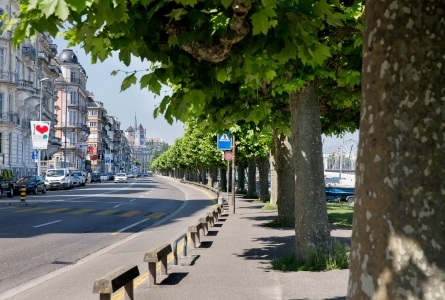To combat heat islands and foster biodiversity, the trees in the City of Geneva will be pruned more lightly. This new approach will help achieve one of the objectives of the revegetation policy of the City of Geneva, which is to increase foliage cover from the current level of 21% of the territory to 30% in 2030.
In order to mitigate the effects of summer heatwaves and help provide a cooler urban environment, the City of Geneva has decided to limit the architectural pruning of its trees. This winter, the Parks and Gardens department avoided pruning more than 360 trees, mostly plane trees.
Subsequently, all 1,400 specimens subject to “cat’s head pruning” – as the form of pruning adopted in Geneva is referred to in reference to the outline of the outgrowths at the end of the branches – will be studied. This will involve analysing their conversion potential with a view to the gradual development of their branches and foliage. Inherited from an aesthetic tradition dating back to the 19th century illustrating man’s desire to conquer nature, “cat’s head pruning” is a form of regular maintenance pruning, often carried out on an annual basis, which aims to retain a limited volume and/or a particular shape of tree.
Increasing the canopy from 21% to 30% across the municipality is a bold objective incorporated into the Administrative Council’s legislature programme 2020-2025. To achieve this goal, different actions are currently under way including a policy of widespread planting, the replacement of each tree felled by three new ones and an increase in the foliage area of existing trees, in particular involving the curtailment or reduction of pruning activities where this proves possible. “Against the backdrop of global warming, we must change our reflexes and habits with regard to traditions which are no longer valid in the modern world,” stresses Alfonso Gomez, Administrative Councillor responsible for Finance, Housing and the Environment. “To combat heat islands effectively and improve the quality of life in the city, increasing the number of plants in town has become an urgent requirement. In an area as compact and densely populated as ours, any lever available to us must be used in order to extend the canopy. Wherever possible, we must help nature to assert its rights.”
Reduced pruning to enhance the canopy and biodiversity
Abandoning pruning leads to an increase in the number of leaves, which in turn provides numerous benefits such as a reduction in heat islands through greater shade on the ground, greater biodiversity (flora and fauna), larger green areas, a greater presence of nature in the city and better air filtering. The more leaves there are, the more photosynthesis occurs and the more carbon dioxide is absorbed. At the heart of highly urbanised neighbourhoods, for example on rue Dancet and rue Hoffmann, the temperature rises quickly in summer. The increased foliage will, over time, create cooler and shadier areas. Along the quaysides, which are always busier in the hot weather, the development of trees will provide welcome shade for the thousands of people enjoying a stroll or relaxing on the grass.
A step-by-step approach
Converting these sculpted trees into freely-growing organisms requires highly specialised know-how. The trees concerned must first be analysed by experts then monitored individually. It is a matter of once again giving the plane trees and lime trees subject to “cat’s head” pruning the ability to bear their new branches and leaves, gradually developing their resistance to the wind while ensuring they live in harmony with the surrounding infrastructures in light of the space available. The conversion from a pruned tree to a naturally growing trees takes about 8 years. Throughout this period, each tree will benefit from specific care adapted to its situation, while scaffold branches will be selected and maintained in order to bear the change. This year, pruning has already been abandoned on more than 360 trees deemed to be in good condition. The thousands of other trees subject to “cat’s head” pruning will be inspected in the coming months. Any subsequent pruning will be carried out on trees due to road traffic considerations, to clear the tram lines, because of their location in very close proximity to surrounding buildings or due to the health of the trees themselves.
Involving everyone concerned
Numerous European cities have already gained experience in reconverting trees, such as Lyon and Strasbourg, cities where successful actions offer a wealth of experience. The City of Geneva also hopes to serve as an example to other municipalities, building management organisations and private owners who can also contribute to increasing the general urban foliage cover.
Contact
Vaucher Anna
Département des finances, de l'environnement et du logement
Collaboratrice personnelle
5, rue de l'Hôtel-de-Ville
1204
Genève
Suisse
Article modifié le 08.02.2022 à 11:56

